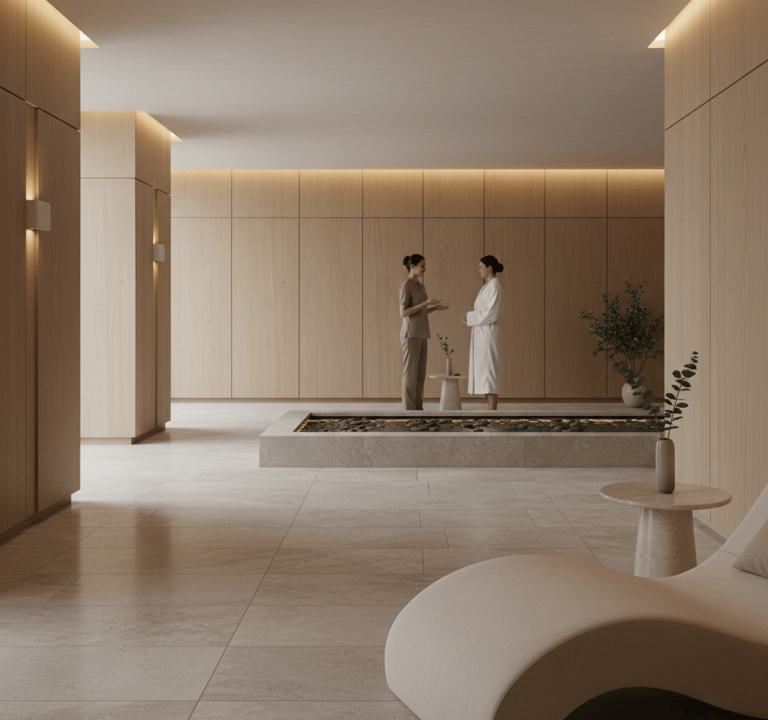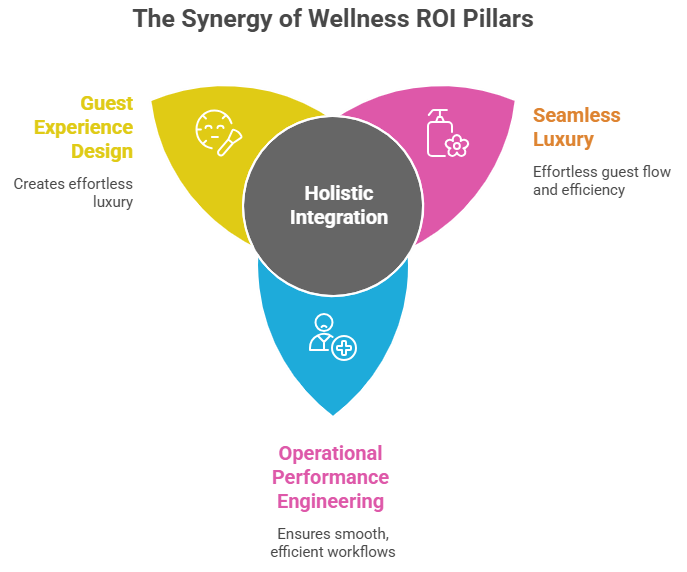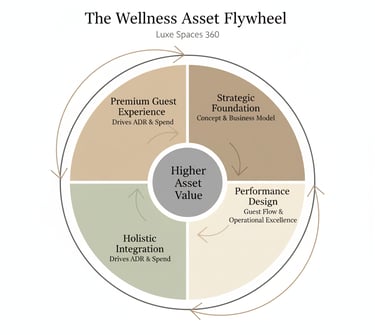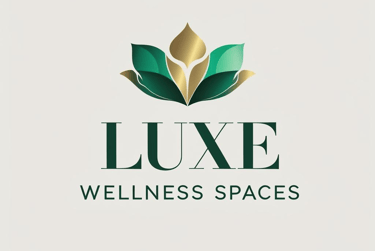The New ROI: How Wellness Design Lifts Hotel Asset Value
Stop guessing at hotel wellness design ROI. Learn how strategic design moves beyond aesthetics to directly increase asset value and ADR. Elevate your asset.
Daryn Berriman
11/4/20255 min read


That new multi-million dollar spa is beautiful. But is it profitable?
For too many hotel owners, the wellness center is a "must-have" amenity that quietly bleeds money. It's a line item, a cost center, and a beautiful, empty space that operators struggle to justify.
Strategic wellness design creates measurable ROI by transforming that cost center into a high-margin profit driver. It's not about gold-plated fixtures; it's about data-driven layouts that optimize guest flow, increase spend-per-guest, and integrate seamlessly with the entire hotel's revenue strategy. This intentional design directly increases Average Daily Rate (ADR) and, ultimately, the total asset value of the property.
The stakes are no longer just about guest satisfaction. A poorly planned spa is a massive, depreciating liability. It creates operational bottlenecks, burns staff, and sits half-empty. But a strategically designed wellness space becomes a primary booking driver. It attracts a high-value guest, extends their length of stay, and generates revenue far beyond the spa doors.
Moving from "Amenity" to "Asset"
The old model was simple: build a spa because your competitors have one. An architect would design a space, an operator would inherit it, and the finance team would sigh. The new model treats wellness as a core commercial asset. This approach, which we call "performance-first", begins with commercial and operational questions, not just aesthetic ones:
What are the revenue-per-square-foot goals?
How does the user journey map to upsell opportunities?
How can the staffing model be lean but effective?
How does this space drive room bookings or residential sales?
When you build from this foundation, the design becomes a tool to achieve those commercial goals.
The Three Pillars of Wellness ROI
True ROI doesn't come from a single element. It's the fusion of three distinct, integrated pillars.
Pillar 1: Designing for Guest Experience (and Spend)
A luxury guest experience should feel effortless. But "effortless" is meticulously engineered.
Strategic design guides a guest through a journey that maximizes both relaxation and revenue. This includes designing "dwell time" in retail zones, creating social spaces that encourage F&B spend, and planning treatment rooms that can be turned around quickly. The goal is a seamless flow that feels like quiet luxury but is built for high performance.
Pillar 2: Engineering for Operational Performance
This is where most beautiful designs fail. A changing room that's too small creates a bottleneck at 5 PM. A treatment menu that requires three different rooms for one service destroys profitability.
Operational design focuses on the "backstage." We analyze workflow, staffing models, and procurement needs before a single wall is built. This ensures the space you have supports the business you want to run. It lowers staff stress, reduces operating costs, and allows your team to focus on the guest, not on fighting the building.
Pillar 3: Integrating for Total Asset Uplift
A truly strategic wellness space functions as an engine for the entire property. It shouldn't be siloed.
We build the wellness strategy to align with the hotel's brand architecture and guest segmentation. This means the spa, fitness, F&B, and even in-room offerings work together. A guest's "wellness journey" might start with a spa treatment, connect to a healthy meal at the restaurant, and end with an in-room recovery tool. This holistic integration drives revenue across all departments and makes the entire asset more valuable.


The Costly Mistake: Designing in a Silo
The single most expensive mistake a hotel developer can make is hiring an architect to design a spa without an operator or wellness strategist in the room.
The result is almost always the same: a stunning space that is operationally dysfunctional. The design isn't informed by the business plan , the staffing model , or the target user journey. This leads to expensive retrofits, inefficient service, and a permanently capped revenue ceiling.
An integrated, end-to-end approach —where strategy, design, and operational planning happen together—prevents this. It ensures the business model dictates the design, not the other way around.
The Counter-Intuitive Truth: "Quiet Luxury" Outperforms "Wow Factor"
Many properties chase the "wow factor" with flashy trends. But in high-end wellness, trends die fast. That gold-plated steam room looks dated in three years, and its ROI plummets.
The contrary, and more profitable, truth is that "quiet luxury" delivers far greater long-term asset value. This aesthetic, defined by timeless materials, intelligent lighting, and effortless flow, feels premium and human-centric. It doesn't scream for attention, so it doesn't fall out of fashion.
This approach is also commercially smarter. It focuses investment on high-impact, long-lasting elements (like flow, acoustics, and flexibility) rather than on depreciating "wow" features. The result is a space that performs better, for longer, with a higher residual value.
Your Wellness Space Is a Commercial Asset
Your wellness space shouldn't be a question mark on your balance sheet. It should be one of your most powerful commercial assets.
When strategy, operations, and design are one, the result isn't just a beautiful spa. It's a more valuable and profitable hotel. But this shift doesn't happen by accident. It requires a performance-first approach from day one.
Is your wellness facility truly performing? Many operators struggle to balance guest expectations with ROI. Luxe Wellness Spaces provides end-to-end consultancy to bridge that gap. We partner with resorts and developers to design and optimize wellness environments that deliver both user delight and commercial success.
Contact us for a strategic assessment to identify the gap between your current performance and your asset's true potential.
FAQ's
How do you measure the ROI of a hotel spa? Spa ROI is measured beyond just treatment revenue. A full commercial model includes:
Direct Revenue: Treatments, retail, F&B, memberships.
Operational Efficiency: Metrics like revenue-per-available-treatment-hour, staff utilization, and cost-of-goods-sold (COGS).
Indirect Impact (Asset Uplift): The "halo effect" on hotel ADR, increased length-of-stay, and its value as a booking driver for high-value guests. Strategic consultants use business modeling from the start to track all of these KPIs.
Can a better spa design really increase hotel ADR? Yes, absolutely. A premium, in-demand wellness facility is a powerful differentiator that allows a hotel to command a higher room rate. It attracts a high-value guest demographic that is willing to pay more for a holistic luxury experience. The wellness offering moves from a simple amenity to a core part of the brand's value proposition, justifying a higher ADR.
What is the biggest mistake in hotel wellness design? The biggest mistake is designing the space in a silo. This happens when an architect or interior designer creates a "beautiful box" without a data-driven strategy or operational plan. The resulting space is often operationally inefficient, difficult to staff, and disconnected from the hotel's commercial goals, leading to a poor ROI.
What is the difference between a spa consultant and an interior designer? An interior designer focuses primarily on the aesthetics and feel of a space. A specialist wellness consultant, like Luxe Wellness Spaces, integrates design with commercial strategy and operational excellence. We develop the business model , map the user journey , engineer the operational workflow , and then guide the design to ensure the final space is not only beautiful but also profitable and efficient.
Further reading on our blog: Further reading on our blog: 'The Regenerative Wellness Trends That Actually Drive Profit.'
Learn more about the blog author and our principal consultant at Luxe Wellness Spaces.
Explore our Spa & Wellness Consultancy to scope project phases and services.
See how we structure Fitness and Leisure concepts before you commit to equipment.
Learn why Luxe Wellness Spaces blends design, operations, and growth under one roof.
View a Concept-to-Launch case study that hit break-even in 90 days.
Reference List




